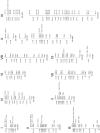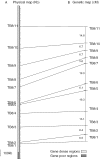The genetic map and comparative analysis with the physical map of Trypanosoma brucei
- PMID: 16314301
- PMCID: PMC1297707
- DOI: 10.1093/nar/gki980
The genetic map and comparative analysis with the physical map of Trypanosoma brucei
Erratum in
- Nucleic Acids Res. 2006;34(2):764
Abstract
Trypanosoma brucei is the causative agent of African sleeping sickness in humans and contributes to the debilitating disease 'Nagana' in cattle. To date we know little about the genes that determine drug resistance, host specificity, pathogenesis and virulence in these parasites. The availability of the complete genome sequence and the ability of the parasite to undergo genetic exchange have allowed genetic investigations into this parasite and here we report the first genetic map of T.brucei for the genome reference stock TREU 927, comprising of 182 markers and 11 major linkage groups, that correspond to the 11 previously identified chromosomes. The genetic map provides 90% probability of a marker being 11 cM from any given locus. Its comparison to the available physical map has revealed the average physical size of a recombination unit to be 15.6 Kb/cM. The genetic map coupled with the genome sequence and the ability to undertake crosses presents a new approach to identifying genes relevant to the disease and its prevention in this important pathogen through forward genetic analysis and positional cloning.
Figures




References
-
- Su X., Kirkman L.A., Fujioka H., Wellems T.E. Complex polymorphisms in an approximately 330 kDa protein are linked to chloroquine-resistant P. falciparum in Southeast Asia and Africa. Cell. 1997;91:593–603. - PubMed
-
- Ferdig M.T., Cooper R.A., Mu J., Deng B., Joy D.A., Su X.Z., Wellems T.E. Dissecting the loci of low-level quinine resistance in malaria parasites. Mol. Microbiol. 2004;52:985–997. - PubMed
-
- Fidock D.A., Nomura T., Talley A.K., Cooper R.A., Dzekunov S.M., Ferdig M.T., Ursos L.M., Sidhu A.B., Naude B., Deitsch K.W., et al. Mutations in the P. falciparum digestive vacuole transmembrane protein PfCRT and evidence for their role in chloroquine resistance. Mol. Cell. 2000;6:861–871. - PMC - PubMed

